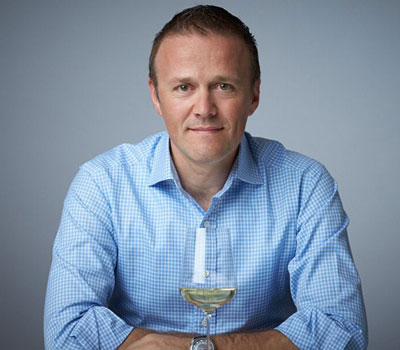Of the 1,000 bottles Aldo Sohm and his team list at Le Bernardin, two-thirds of the wines they sell are white. That’s not surprising in one of the greatest fish restaurants in the world. But you might not expect to see Corison Napa Valley Cabernet or Bourgneuf Pomerol among the ten best-selling wines. Chef Eric Ripert likes to drink red Bordeaux with many of the fish preparations on the menu, and guests do as well. But when they put themselves in the sommelier’s hands, they’re likely to get white Burgundy or grüner veltliner from Austria, where Sohm himself produces one with Gerhard Kracher. Josh Greene caught up with Sohm at his wine bar across from Le Bernardin, where they shared a glass of the Sohm & Kracher grüner and talked about sales in the fourth quarter of 2017.


On wine sales increasing and menu prices increasing…
Our costs have gone up significantly—operating costs—and we also give health care to employees; that goes up. So where to do you get it? We have put up the prices. Yet we sold more wine than in previous years. The economy is good. Everyone seemed to make a lot of money last year. I see our guests are more centered and more specific. It’s mainly that I know these people and there’s a mutual trust. I’m here for ten years now; I go to a table and I don’t bring the wine list anymore. Some guests want to drink their Burgundies, some want to drink their Bordeaux. Some say, ‘Don’t give me Coche or Roulot; give me new wines.’
A Meursault on top.
We pushed the Vincent Latour, a cool little guy. We had it by the glass also. Many people said, ‘I like this wine, let’s have a bottle.’ How many Meursaults do you get for $120 a bottle, especially from a single vineyard? Almost none. That’s probably one reason our sales are up. If I can drink a Meursault for $120 versus a Sancerre for $90…that $30 ups the overall sales.
And Sancerre still comes in as your number three top-selling wine by the bottle.
Sancerre prices have developed. They are not cheap anymore. I am always afraid to put Sancerre on by the glass. If you do, your entire by the glass program collapses. Whether we wine geeks agree, the customer has a tendency to go with Sancerre. It’s a safe choice, it’s in trend; you don’t look stupid.
There’s no Champagne among your best-selling bottles.
We welcome people with a lot of Champagne. We comp it, mostly, so I don’t include it [in the sales report]. Champagne is a weird category. I love it, but for a consumer, it’s for something to celebrate with. Even then, they have a glass of Champagne and go straight into white wine.
I’ll tell you a story. My girlfriend and I went to Momofuku Ko for the tasting menu. I saw they had Chartogne-Taillet Couarres Château, an Extra Brut Champagne [blended from chardonnay, petit meslier, arbanne and pinot blanc]. I thought, perfect. Then I asked my girlfriend and she said, nah, let’s have white wine.
How is it that a Burgenland Blaufränkisch was the biggest new success at Le Bernardin?
I have Katia [Scharnagl], who is from Austria, basically my right hand. I am from Austria, obviously. People trust us and people are looking for alternatives. They are open to discover new wines. I’m going to pull really interesting wines that would be comparable to great French wines. In the last seven years, when you look at price developments with Bordeaux, Burgundy, Rhône, it’s up, up, up. [Austrian blaufränkisch] is the type of wine that has the opportunity to work with the food at Le Bernardin incredibly well.
On pricing
At Aldo Sohm Wine Bar, I wanted to have a wine you could buy for $11 in a Zalto glass, and an expensive wine as well. Then when we promote sommeliers from Aldo Sohm Wine Bar to Le Bernardin, they get used to it and they say, ‘Oh, this guy only ordered a $250 bottle of wine.’ ‘Only?’ I ask them, ‘How often do you go out and order $250 bottles of wine?’
It’s like this category of $20 wine. It’s hard to find good wine for $20 at retail. And if a wine on a list is too cheap, people won’t buy it. If you put a really interesting wine on the list for $40, no one will buy it. You need a stretch of prices. You cannot have only $1,000 bottles and you cannot have only $50 and below, either. We have $2,000 bottles and $35 bottles. If I gave a couple of attorneys who had just closed a major deal a $35 wine and said, ‘It’s great,’ they wouldn’t want it. With only $50 and below, you’re doing a disservice. It has to be a healthy balance.
photo by Thomas Schauer
Joshua Greene is the editor and publisher of Wine & Spirits magazine.
















